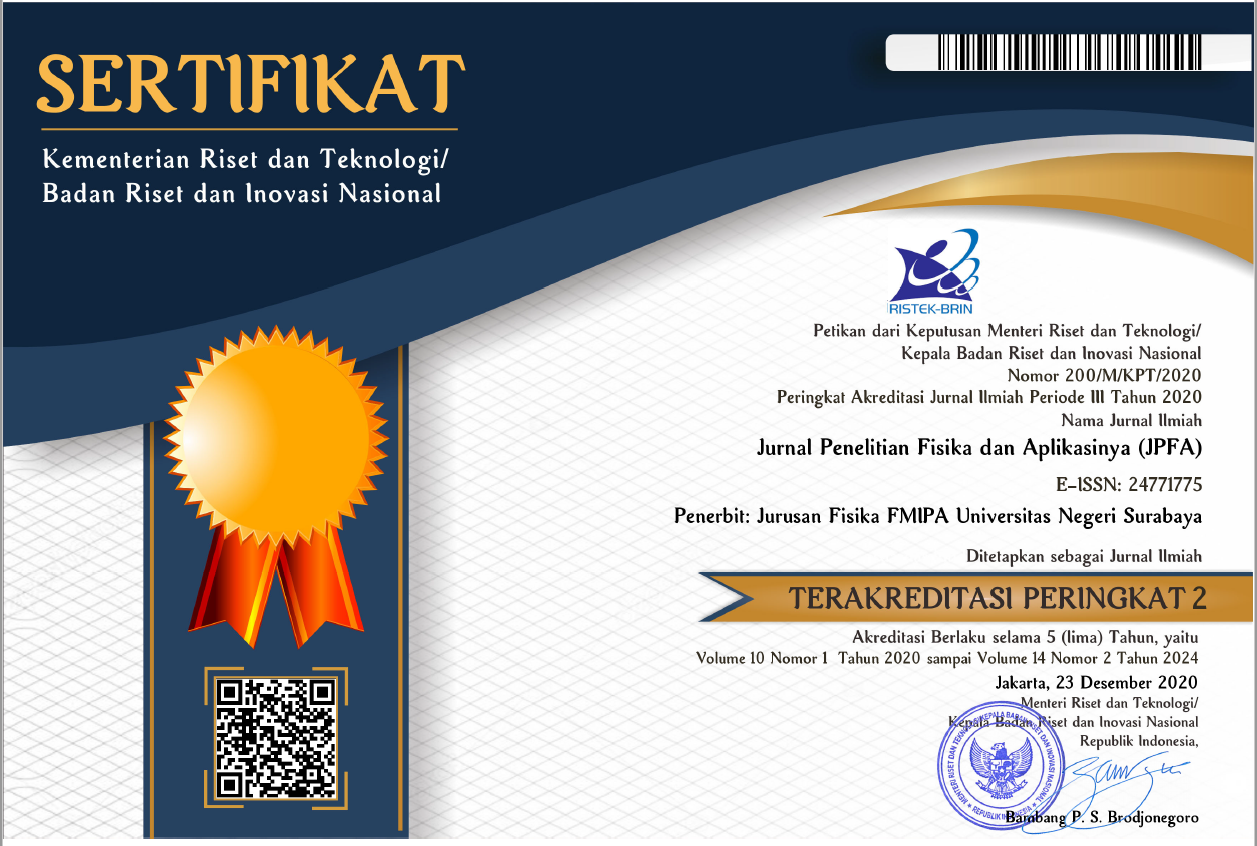GROWTH AND PROPERTIES OF STACKED SELF-ASSEMBLED In0.5Ga0.5As QUANTUM DOTS
DOI:
https://doi.org/10.26740/jpfa.v2n1.p1-6Keywords:
Quantum Dots, In0.5Ga0.5As, MOCVD, AFM, PhotoluminescenAbstract
Self-assembled In0.5Ga0.5As quantum dots (QDs) were grown using metal-organic chemical vapor deposition (MOCVD) on GaAs (100) substrate with different number of stacking QDs layers. Surface study using atomic force microscopy (AFM) shows that surface morphology of the self-assembled QDs change with different number of stacking QDs layers caused by the previous QDs layers and the thickness of the GaAs spacer layers. PL measurement shows variation in the PL spectra as a function of number of stacking layers of In0.5Ga0.5As QDs. The PL peak positions blue-shifted from 1225 nm to 1095 nm and dramatically increase in intensity with increasing number of stacking QDs layers.
References
Suárez, F., Granados, D., Dotor, M. L., and GarcÃa, J. M. (2004), Laser devices with stacked layers of InGaAs/GaAs quantum rings, Nanotechnology, Vol. 15, pp. S126-S130
Yang, T., Tatebayashi, J., Nishioka, M., and Arakawa, Y. (2008), Effects of accumulated strain on the surface and optical properties of stacked 1.3 ïm InAs/GaAs quantum dot structures, Physica E, Vol. 40, pp. 2182-2184.
Li, S., and Koike, K. (2005), Surface morphology of self-assembled vertically stacked InAs quantum dots by atomic force microscopy, Ultramicroscopy, Vol. 105, pp. 125-128.
Gray, L., Stintz, A., Malloy, K. J., Newell, T. C., and Lester, L. F. (2001), Morphology and relaxation in InyGa1-yAs/GaAs multi-layer structures, J. Crystal Growth, Vol. 222, pp. 726-734.
Ng, J., and Missous, M. (2006), Improvements of stacked self assembled InAs/GaAs quantum dot structures for 1.3 um applications, Microelectronics Journal, Vol. 37, pp. 1446-1450.
Signore, M. A., Tasco, V., Pascali, C., Tarantini, I., and Passaseo, A. (2003), Morphological characterization of InGaAs QDs MOCVD-grown in Nitrogen atmosphere. 10th European Workshop on MOVPE, Lecce, Italy, 8−11 June 2003.
Aryanto, D., Ismail, A. K., and Othaman. Z. (2010), Morphology and optical properties of self-assembled In0.5Ga0.5As quantum dots with different spacer layer thickness, Tsinghua Science and Technology, Vol. 15(5), pp. 534-539.
Zhang, X. B., Ryou, J. H., Dupuis, R. D., He, L., Hull, R., Walter, G., and Holonyak, N. (2006), Effect of thin strain-compensated Al0.6Ga0.4P layers on the growth of multiple-stacked InP/In0.5Al0.3Ga0.2P quantum dots, J. Electronic Materials, Vol. 35(4), pp. 701-704.
Wasilewski, Z. R., Fafard, S., McCaffrey. J. P. (1999), Size and shape engineering of vertically stacked self-assembled quantum dots, J. Crystal Growth, Vol. 201/202, pp. 1131-1135.
Ilahi, B., Sfaxi, L., Hassen, F., Salem, B., Bremond, G., Marty, O., Bouzaiene, L., and Maaref, H. (2006), Optimizing the spacer layer thickness of vertically stacked InAs/GaAs quantum dots, Materials Science and Engineering C, Vol. 26, pp. 374-377.
Hazdra, P., Voves, J., Oswald, J., Kuldová, K., Hospodková, A., Hulicius, E., and Pangrác, J. (2007), Optical characterisation of MOVPE grown vertically correlated InAs/GaAs quantum dots, Microelectronics Journal, doi:10.1016/j.mejo.2007.06.005.
Nakata, Y., Sugiyama, Y., Futatsugi, T., and Yokoyama. N. (1997), Selfassembled structures of closely stacked InAs islands grown on GaAs by molecular beam epitaxy. J. Crystal Growth, Vol. 175/176, pp. 713-719.
Kamiya, I., Tanaka, I., and Sakaki, H. (1998), Optical properties of near surface-InAs quantum dots and their formation processes, Physica E, Vol. 2, pp. 637-642.
Germann, T. D., Strittmatter, A., Kettler, Th., Posilovic, K., Pohl, U. W., and Bimberg, D. (2007), MOCVD of InGaAs/GaAs quantum dots for lasers emitting close to 1.3 um, J. Crystal Growth, Vol. 298, pp. 591-594
Downloads
Published
How to Cite
Issue
Section
License
Author(s) who wish to publish with this journal should agree to the following terms:
- Author(s) retain copyright and grant the journal right of first publication with the work simultaneously licensed under a Creative Commons Attribution-Non Commercial 4.0 License (CC BY-NC) that allows others to share the work with an acknowledgement of the work's authorship and initial publication in this journal for noncommercial purposes.
- Author(s) are able to enter into separate, additional contractual arrangements for the non-exclusive distribution of the journal's published version of the work (e.g., post it to an institutional repository or publish it in a book), with an acknowledgement of its initial publication in this journal.
The publisher publish and distribute the Article with the copyright notice to the JPFA with the article license CC-BY-NC 4.0.
 Abstract views: 476
,
Abstract views: 476
, PDF Downloads: 427
PDF Downloads: 427








